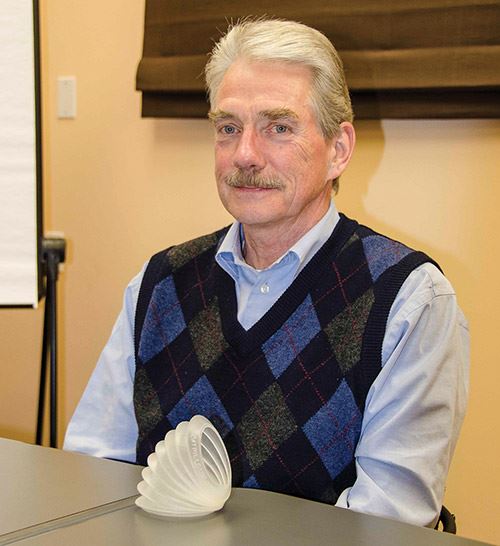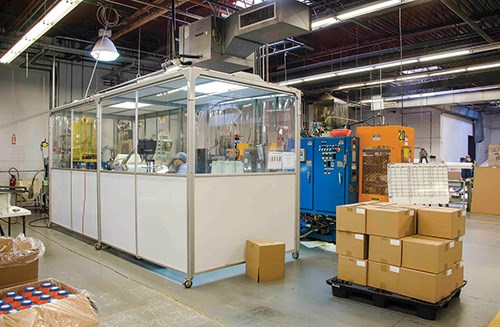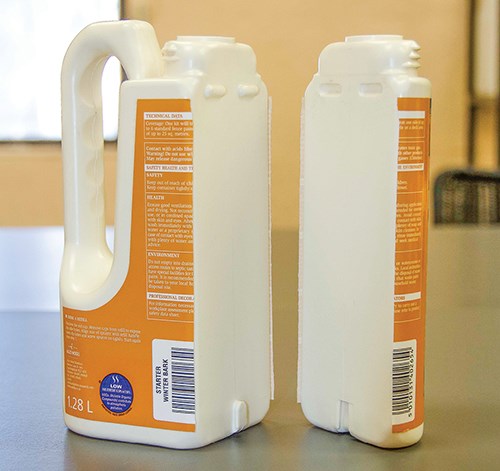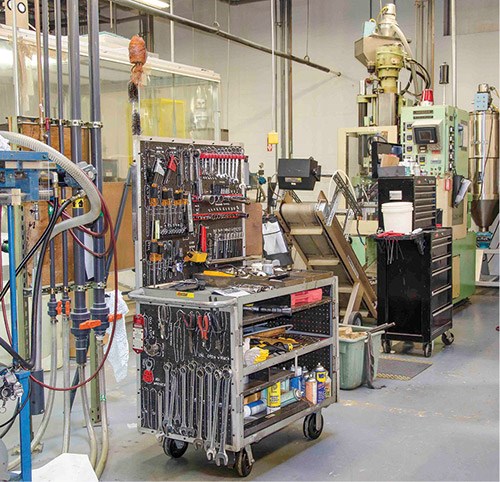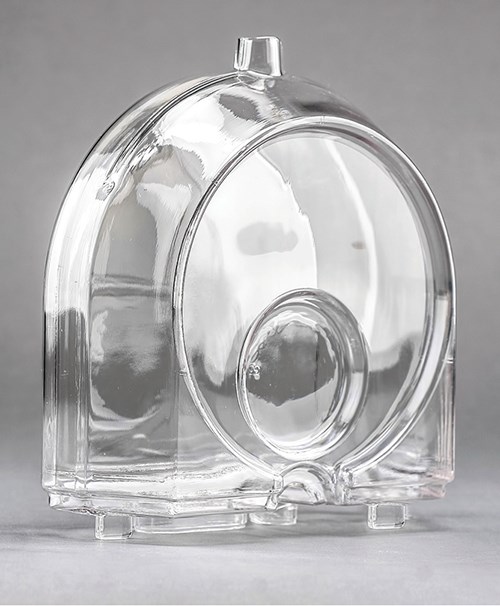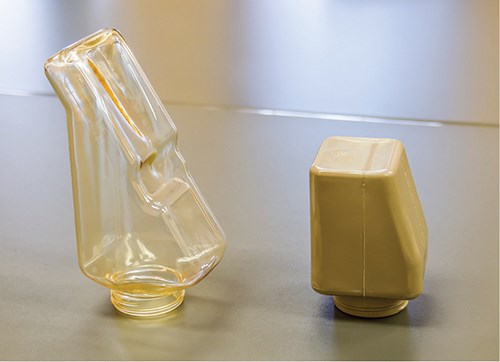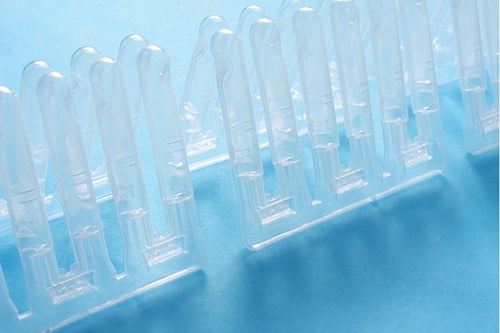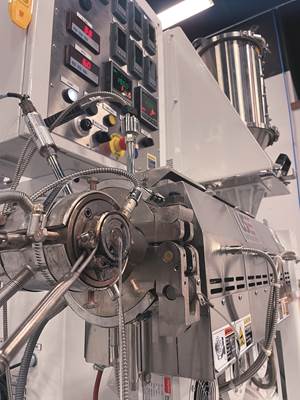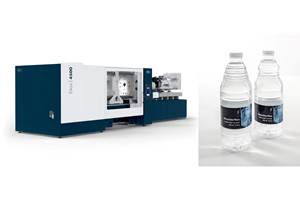This Blow Molder Tackles Technical Parts That Others Won’t Touch
On-Site: Blow Molded Specialties
Tom Boyd is used to incredulous looks from potential customers.
Tom Boyd is used to incredulous looks from potential customers. Show one of them a squarish PETG blood-processing device with multiple ports of different sizes and tight dimensional tolerances, and a typical reaction is, You’re telling me that’s a blow molded part? I thought it was two injection molded pieces stuck together!
“We continually have to educate people about what blow molding can accomplish—even people in plastics,” says Boyd, founder and president of Blow Molded Specialties (BMS) in Pawtucket, R.I. His firm uses various types of extrusion blow molding—continuous extrusion, reciprocating screw, and accumulator head—to mold complex, tight-tolerance parts for medical, laboratory, and other demanding applications. “Most people think blow molding is just for loose-tolerance parts like toys or dairy and juice bottles. We have to show them our technical problem-solving skills. We tackle challenges other blow molders won’t go near.”
REINVENTING THE BUSINESS
Actually, Boyd knows a lot about dairy and juice bottles—that’s where he got his start in blow molding. Starting as a mechanical engineer in 1970, he gained experience in manufacturing with firms like Dixon Industries, Western Electric, Baxter Healthcare, and a custom injection molder. Then in 1985 he was hired to oversee Northeast Container, a small blow molder of dairy bottles. Boyd could see that business being gobbled up by a large regional dairy, so he diversified into water jugs, but even that market would soon be out of reach.
In 1988, Boyd was approached by a local medical device maker that had in-house injection molding but needed blow molded parts for irrigation kits and enteral feeding bottles. It so happened that a nearby molder had a couple of small blow molding machines making medical laboratory pipettes but wanted to get out of blow molding and focus on its core business of injection molding. So Boyd bought the machines and started his own business in a corner of the dairy molding plant.
When Northeast Container inevitably closed down, Boyd rented space for BMS from a medical device manufacturer who needed blow molded parts. He gained other work in custom containers and bicycle water bottles. After about 10 years, BMS moved to its present location. Today, the 35,000 ft2 plant houses 13 Rocheleau, Hayssen, and Heins machines with part size capacity up to about 1 gallon. The machines are 10 to 35 years old, though the controls have been upgraded along the way. With the exception of controls, blow molding technology has not evolved that much in recent decades—not nearly as much as injection molding, in Boyd’s view.
With a current staff of 30, the firm has grown to annual revenue around $4 million. About 85% of that is medical and laboratory related, with the remainder in food packaging, water-quality sampling, mattress air bladders, and dispensing ink containers.
“We’ve been through a few reinventions of the business,” Boyd notes. “We never wanted to be in low-margin, high-volume applications. Our first concept was to pursue medical. I had a background at sophisticated manufacturers, and other small blow molders in this area had no such experience.”
Then along came NAFTA in 1996, and 40% of his business took off for Mexico within six months. “I realized we couldn’t be just regional anymore. But in order to seek wider markets, the question was how to overcome the freight cost for hollow objects, since we’re essentially shipping air.”
The answer came in three parts:
- Make small parts.
- Make difficult-to-mold parts that others wouldn’t try or couldn’t do successfully.
- Mold difficult materials that few others could handle.
“We’re now in the midst of another reinvention,” Boyd says. “Since the 2009 recession, our last custom bottles went commodity on us. Should we get down in the trenches and fight for low-priced business? Better to stick with what we know—specialty device components that have to perform a function and also have to fit into the part and work with the rest of the assembly.”
“We’re a specialized technical blow molder,” says Sarah Cook, whom Boyd hired in 2005 as the firm’s first full-time sales and marketing coordinator. BMS still makes at least one fairly
standard bottle, albeit for a medical customer—a 24-hr urine collection bottle in HDPE. But most of its parts are unusual shapes that require careful control of dimensions and wall thickness. “We push the edge of the envelope,” Cook adds.
“We’ll take risks, try anything,” Boyd confirms. Examples of challenging jobs were a “locking bellows” that could be twisted to an angled shape and hold that configuration; and a thin, flexible, square part with two chambers and ports. Also, a double-bottle paint-spray system, though never commercialized, proved the ability to mold two different parts in the same machine simultaneously that had mating projections and recesses for interlocking dovetail joints (see photo). More examples of especially challenging parts are displayed on the company website.
Taking risks does not guarantee success. “Sometimes we find ourselves in hot water,” Boyd admits. “A customer wanted a rectangular bellows, but we couldn’t get the wall thickness uniform enough to make it work.”
BMS blow molds a wide variety of materials—besides PE, PP, and EVA, also ABS, polycarbonate, PETG, Barex acrylonitrile-copolymer barrier resin, PEEK, polysulfone, polyphenylsulfone, and TPEs like K-Resin styrenic copolymer and Hytrel copolyester. The
firm’s applications typically require 100% virgin resin, so it grinds and resells its scrap.
BMS does mostly short runs of 5000 to 100,000 parts. It makes more than five job changes a week. Says Cook, “We’re experts at changeovers, like from Hytrel or polysulfone to another resin. We mostly have to pull and clean screws and other components, rather than rely on purging. It’s not so much about speed of changeover, but thoroughness, so we can get up and running good parts in the minimum time for the next job.”
“We have setup carts with a complete kit of what’s needed going into the next job,” adds Boyd. “We try to get as much possible done to prepare for the next run before the mold goes into the press.”
SELLING ENGINEERING EXPERTISE
“To be effective in medical devices, we must get in at the beginning,” says Boyd. “It takes years to get new products to market. We have a dozen projects in the works now.”
To get those jobs, he explains, “We do a lot of engineering work. And we charge for it, though some blow molders don’t. Based on experience, we’ll tell a customer, ‘It will take three to five trials to get this right.’ Then we’ll charge for the actual number it takes.”
BMS markets its engineering skills as its Value Development Process (VDP). Though the firm does not design parts or molds, its contribution is in process development—determining the
proper mold temperature and mold closing speed, parison profile, parison shape (not always round), and the proper timing of blowing air, especially when it comes in from multiple locations.
As Boyd puts it, “Our VDP is how we find out where the snakes in the grass lie, so we can come in on time and on budget. It takes a lot of trial and error. There are a lot more ‘ifs’ in blow molding. A perfectly designed blow mold can still make unacceptable parts. Often we have critical inside dimensions that are not controlled by tooling but only by air pressure and wall thickness. And the blow molding process has more variables than injection molding. The part is hanging out in midair. So we must control ambient conditions as much as possible.”
“Our success is based on two things,” says Cook, “our technology and our people.” The BMS management team has been with the firm for at least seven to 15 years, and a handful
of manufacturing staff have 15 or more years’ tenure.
“It’s very hard to find trained blow molding technicians,” Boyd points out. “We have trained some people who come from injection molding backgrounds, and some with stretch-blow or wheel blow molding experience, who don’t immediately relate to our process.”
To upgrade its staff’s skills, BMS hired a Six-Sigma black belt consultant to train the staff in statistical process control (SPC) and total predictive maintenance (TPM). A handful of staff have attained Six-Sigma green belt status. And the firm requests ISO 9001 audits twice a year instead of the required annual audit. “We do it because it keeps us on our toes and challenges us to make continuous improvements,” says Cook.
An important staff development program, Boyd notes, involves educating shop-floor people, even material handlers and packers, and their supervisors in how to run and adjust the machines. “Some of them may go on to become technicians. But it gives all of them more understanding, more of an ownership mentality in all that they do.”
Boyd says BMS doesn’t get much foreign competition. “In fact, we make a part that’s shipped to Malaysia to be assembled and then shipped back to the U.S. as a finished product. We also mold a DNA testing reagent container that started production in China. But they couldn’t do it right, so it came back here to us.”
BMS doesn’t have a lot of domestic competition, either. It’s now the only non-dairy custom blow molder in the state, down from three previously.
Related Content
Medical Tubing: Use Simulation to Troubleshoot, Optimize Processing & Dies
Extrusion simulations can be useful in anticipating issues and running “what-if” scenarios to size extruders and design dies for extrusion projects. It should be used at early stages of any project to avoid trial and error and remaking tooling.
Read MoreCatheter Specialist Finds Sweet Spot Serving Small, Medium-Sized Concerns
Medical-component specialist LightningCath has carved a niche meeting the needs of small to medium-sized entrepreneurs with complex catheter designs … quickly.
Read More3D Printed Spine Implants Made From PEEK Now in Production
Medical device manufacturer Curiteva is producing two families of spinal implants using a proprietary process for 3D printing porous polyether ether ketone (PEEK).
Read MoreKrones Acquires Netstal
Krones adds PET preform injection molding to its bottle blowing and filling capabilities, as well as cap molding and expansion into medical, food and other markets.
Read MoreRead Next
See Recyclers Close the Loop on Trade Show Production Scrap at NPE2024
A collaboration between show organizer PLASTICS, recycler CPR and size reduction experts WEIMA and Conair recovered and recycled all production scrap at NPE2024.
Read MoreFor PLASTICS' CEO Seaholm, NPE to Shine Light on Sustainability Successes
With advocacy, communication and sustainability as three main pillars, Seaholm leads a trade association to NPE that ‘is more active today than we have ever been.’
Read MorePeople 4.0 – How to Get Buy-In from Your Staff for Industry 4.0 Systems
Implementing a production monitoring system as the foundation of a ‘smart factory’ is about integrating people with new technology as much as it is about integrating machines and computers. Here are tips from a company that has gone through the process.
Read More

